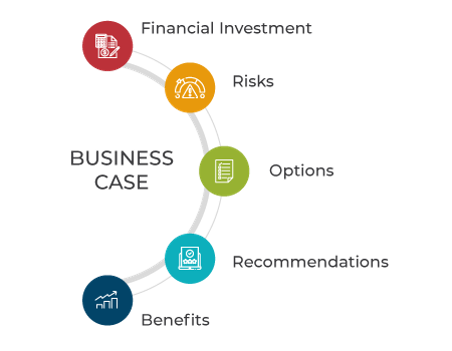
In every organization, a new project needs adequate justification for approval and budget allocation. The introduction of a new IT service is counted as a project as it needs financial investment along with many hours to be spent implementing it. If the new service does not add value to the company’s business activities or does not bring a discernible financial gain, then it would be an unproductive investment.
To find out the possible consequences of a project such as the investment of a new IT service, we need a tool that lets us project the possible consequences of the action. Such a tool, which enables us to determine all the likely quantitative and qualitative consequences of the action taken, is called a business case.
Responsibility of the Management
Even in an IT company, there will be two main divisions.
The IT service division is in charge of developing new products and maintaining existing ones. And the business and management division handles the financial transactions, and business contracts and aims to maximize the profits from the IT services. The IT division often develops products that might be advanced but might not work out for the company financially.
Hence it is the duty of the management to ask the right questions like:
- Why is the particular service needed?
- How will it add value to our business?
- Will it give enough financial returns to justify an investment?
Without answering these important questions, the IT department will not be allowed to proceed with the project as even an advanced service that has no place in the company can damage the core competency of the organization. The questions focus on financial and non-financial parts of the business as well.
This is known as a business case as the IT department will have to showcase that there is a viable business model for the newly developed service before it gets approval for implementation.
What is in a Business Case?

Financial Investment
This is a major aspect of the business case as no compromises can be made. The IT developers will have to specify the exact costs to implement the service and the costs to keep it running for the foreseeable future.
Risks
The complications which can arise as a result of the new IT service implementation, as well as the potential losses and damages which can be caused, should be detailed.
Options
Different options should be included, mentioning alternatives with differing financial investments, risks, and benefits.
Recommendations
One of the most important things is to recommend what the company can do with the new service so that it can be utilized effectively at the right time and in the right place.
Benefits
Finally, the benefits offered by implementing the services should be explained. This includes the financial benefits, user experience improvement, publicity, and technological advancements.
What is ITIL Business Relationship Management?
Business Relationship Management is a process that allows Business Relationship Managers (BRMs) to provide effective connections between the service provider and their customers. This allows the service provider to get an understanding of the business requirements of their customers and provide only those services which meet the requirements of the customers.
The measure of customer satisfaction within the service provider’s customer base is a primary indicator of the success of the business relationship management process.
Purpose of ITIL Business Relationship Management
The purpose of the business relationship management process includes the following:
- To identify the needs of the customer and ensure that the service provider also continues to recognize and understand each and every customer and their individual business needs as they change over time.
- Create a useful and effective business relationship between the service provider and their customers.
- To help the customer to understand the value provided by the services and to make sure that their expectations do not exceed their budget which they are willing to pay.
- Make sure that the service provider understands the requirements of the customer completely and is able to meet their expectations before finalizing the deal to deliver the service.
Objectives of ITIL Business Relationship Management
The main objectives of ITIL business relationship management are to permit the service provider to:
- To maintain high levels of customer satisfaction for a sustained period of time.
- Prioritize their service and service assets in order to meet the service requirements from the customer’s perspective.
- Establish constructive business relationships with their customers and maintain them in the future as well.
- Recognize changes in the environments of their customers and the latest trends in technology which could have an impact on their services to individual customers.
- To establish and articulate the business requirements of their customers for services.
- Lodge formal complaints and procedures to escalate them to each of their customers.
- Intervene and mediate in a situation where conflicting requirements arise for the services from different customers.
Scope of ITIL Business Relationship Management
The main focus of the scope of ITIL business relationship management for internal service providers is to align the objectives of the multiple business units with the activities of the IT service provider. This usually requires a senior representative of the IT service provider to interact with equivalent senior managers within the business units.
External service providers usually have their own dedicated and separate business relationship management function. In this group, individuals are known as BRMs or account managers and are assigned to a particular customer.
The business relationship management process focuses on understanding and communicating the following:
- The services which are presently being provided to the customer
- The business outcomes that the customer desires
- How the services are being delivered to the customer
- The technology trends which may impact the current services and the nature of the potential impact of the technology trends upon each customer
- Satisfaction of customers and the present status of plans made to address any dissatisfaction
- The way in which the service provider is represented to the customer
Value of ITIL Business Relationship Management
The following values of business relationship management benefit the service provider’s business.
- The ability to understand, communicate and meet the business requirements of its customers.
- A clear understanding of the business needs of the customers and improvement in the customer awareness of what the service provider is capable of providing.
- An increased level of trust and collaboration between the customer and service provider, allows disagreements to be resolved effectively and services to be provided as per the realistic expectations of the customer.
- It allows for effective dialogue between the service provider and all their customers, which results in the provided services being aligned with the business needs of the customer.
Basic Concepts of ITIL Business Relationship Management
Business Relationship Manager (BRM)
The role of the business relationship manager can be broader than the business relationship management process. This is due to the business relationship manager having a role in other service management processes such as a BRM passing information regarding the requirements of the customer into the service portfolio management process.
Customer Portfolio
The customer portfolio contains a record of all the customers of the service provider. The main purpose of the customer portfolio is to allow the service provider to quantify their commitments, investments, and risks which are relative to each customer. While the data is being utilized by the service portfolio management process and other service management processes, it is defined and maintained entirely by the business management process.
Customer Agreement Portfolio (CAP)
A customer agreement portfolio is basically a database or document which is used by the service provider to manage the service contracts with their customers. The customer agreement portfolio is actually managed under the service level management process, but it is also used by a business relationship manager quite frequently.
Customer Satisfaction
It is the duty of the business relationship management to make sure that the customers of the service provider are satisfied with the quality of services they are receiving. They should also ensure that customer satisfaction is measured and analyzed and that any issues which arise need to be dealt with and addressed in a quick and effective manner.
Service Requirements
It is the duty of business relationship management to define and clarify the service requirements throughout the lifecycle of the service.
Business Relationship Manager as a Facilitator of Strategic Partnerships
Business relationship management is a process that tries to achieve the involvement of the service provider in the strategic discussions of the customers. In addition to that, it makes use of the customer’s willingness to contribute input and feedback to the strategic planning and service improvement activities of the service provider.
Process Activities of ITIL Business Relationship Management
Business relationship management is rarely executed as a single, end-to-end process even though it spans every stage in the service lifecycle.
Basically, there are 2 core activities in business relationship management:
- Representing the service providers to all their customers through activities such as marketing, selling, and delivery.
- Making sure that the responses of the service provider to the requirements of the customer are appropriate, is achieved through work with service portfolio management and design coordination.
Challenges of ITIL Business Relationship Management
The following challenges are faced by business relationship management
- If business relationship management is introduced to work solely on levels of customer satisfaction, it typically tends to fail. It needs to take a holistic approach that has influence in defining and tracking the services which are delivered to the agreed levels.
- If there is no credibility of the service provider, then customers can become reluctant to invest their time in sharing requirements and feedback.
- There is a possibility of confusion between the role of business relationship management and the process of business relationship management.
Risks of ITIL Business Relationship Management
The following risks are encountered during the business relationship management process:
- There is a potential for some activities to be neglected and some activities to be duplicated due to the confusion regarding boundaries between the business management and the other service management process.
- The service provider can prove to be ineffective if there are disconnects between the customer-facing processes and processes focusing more on technology.
Conclusion
An effective ITIL Business Relationship Management serves a great deal of clarity towards the motive of the service, value addition to the organization with the return on the investments that will be spent on the services. Learn more about such practices and processes with ITIL 4 Foundation certification training, and take your service management career to the next level.
Learn more about Service Management best practices through Invensis Learning’s IT Service Management certification training on ITIL 4 Foundation Certification, SIAM Foundation, SIAM professional, VeriSM, etc.















